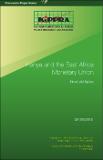| dc.description.abstract | Kenya and other EAC member states are in the process of forming an EAC Monetary Union. Like other regional blocs with similar arrangement, the EAC has put in place macroeconomic convergence criteria. There are macroeconomic targets that member states should fulfill before the commencement of a monetary union. However, questions have emerged on the suitability of EAC monetary unions in terms of their readiness especially against the backdrop of the recent Euro crisis that rocked the European Monetary Union. Using the Optimum Currency Area (OCA) theory, the suitability and viability of the EAC was assessed. This is done using the OCA Index methodology, which is considered robust in terms of assessing the possibility of successful working countries, and in helping to vet out unsuitable countries in a monetary union. The methodology operationalizes the basic OCA variables by constructing their indices. The OCA index was computed for EAC members using panel regression for the period that coincides with the formation of the EAC (2000-2013). The basic OCA variables included in the model were the exchange rate variability, business cycle synchronization, dissimilarity of export commodity structure, trade intensity, and economic size. That is, the more the basic OCA criteria are fulfilled among the member states, the lower the variability of exchange rate should be and the better prepared the member states are. The OCA index computed reveals that EAC member states are not ready for a monetary union. Though the indices were small, most of the variables were not statistically significant. The policy implication drawn from the study is that there is need for full implementation of the custom union and common market so as to increase intra-EAC trade. There is also need to implement macroeconomic policies that strengthen the EAC institutions to improve surveillance and power to sanction member states that do not comply with the EAC policies. | en |

